January 2023: Songs of love
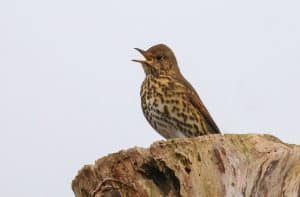
It was Chaucer who gave St Valentine’s Day its romantic associations. In his poem, The Parliament of Fowles, he imagines all the birds coming together on February the 14th to declare their passions and choose their mates. Florists and card manufacturers have been grateful ever since. But hang on, why mid-February? Wouldn’t you expect the mating season to begin in Spring? Well, like all the best-loved British traditions the history is rather murky. Chaucer actually wrote his poem to celebrate a royal wedding on 3 May 1381 between Richard II and Anne of Bohemia and he borrowed the name of a minor Italian saint called Valentine whose feast was by chance celebrated on that day. It was only much later that all the lovey-dovey stuff was cheerfully transferred to the February date, which was itself originally an ancient Roman fertility festival that happened to coincide on the calendar with the death of a quite different saint also called Valentine.
Never mind, there is truth even in literal error. The birds really have started to sing in the early mornings now and for just the reasons Chaucer supposed. Two of the easiest songs to recognise in the February dawn chorus are those of the great tit and song thrush, each of which relies on repeating a few basic phrases loudly and often. The main great tit song is a ringing double note, which is usually represented as teacher-teacher, though they do also have a large repertoire of different calls (up to 80 variants have been separately counted). The song thrush, on the other hand, tends to sing in longer phrases like did-he-do-it, did-he-do-it; too-true, too-true. Or as another poet, Robert Browning, puts it:
That’s the wise thrush; he sings each song twice over
Lest you should think he could never recapture
The first fine careless rapture!
Bird songs are in fact getting both earlier and louder, for reasons Chaucer could never have foreseen over 600 years ago. Earlier, because of climate change, which has advanced the breeding season by some weeks for many birds. And louder, for the sad reason that traffic and other urban noise has now reached levels where courting great tits, for example, have to turn up the volume to press their suit if they live in towns rather than in the countryside. Moreover, some birds with softer and less penetrating voices are now quite unable to hold territories and nest successfully by motorways, even though there are suitable nesting-sites in all those bushes on the verges, because they simply cannot make themselves heard to prospective mates. Now that really is a fable for our time.
Jeremy Mynott
8 January 2023
February 2023: Missing seasons
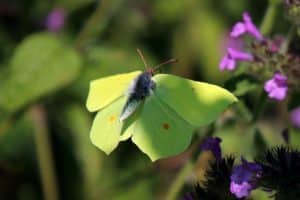
The exciting thing about this time of year is that one keeps seeing the ‘first’ of various things for the year: the first butterfly (usually a floppy yellow brimstone butterfly gliding along a hedge), the first chiffchaff (freshly in from Africa), the first frog spawn (in your garden pond – you should have one if you don’t already), the first bumblebees, the first shoots of green on the hawthorn, the first cowslips in the banks, and so on. I still feel a jolt of adrenaline when each of these appears again, a reassurance, as the poet Ted Hughes put it, ‘that the world’s still working’. More than just a reassurance, though. It’s a joyful sense that the dark days of winter are soon to be replaced by light, warmth and growth. A feeling of abundance and renewal. Who wouldn’t feel the emotional sap rising at such a time?
But it’s getting more complicated, like the rest of life. This ‘spring’ we had the first sticky buds on the chestnuts in January, and the first aconites out in December; there’s been a chiffchaff flitting around all winter; and I’ve just seen my first brimstone, like a floating piece of detached sunlight. Isn’t this good news? It can’t be bad to enjoy the pleasures of spring a month or two earlier, can it? But suppose we are losing the familiar distinctions between the seasons altogether? These are deeply ingrained in our history and culture, and give us our bearings in the natural world. I wouldn’t want a bland, uniform climate in which the cycles of growth and rebirth had been flattened out, even if it was a bit more comfortable.
We’ve got used to this kind of thing in our eating habits, of course. You can now eat fresh raspberries all the year round. And you can buy exotic fruits like avocados at any supermarket or corner store. I don’t suppose I had ever eaten an avocado until I was 30, and if you had asked me as a boy what the word ‘Avocado’ meant I might have guessed at some sort of Church prayer or Mexican board game; but at this rate we may one day see avocados growing in our own back-gardens.
Perpetual spring would actually mean no spring at all. No autumn either, perhaps the loveliest of seasons with its bitter-sweet associations. It was once all so simple in Genesis. ‘While the earth remaineth, seed-time and harvest, and cold and heat, and summer and winter, and day and night shall not cease.’ But if you read it carefully, that was both a promise and a warning.
Jeremy Mynott
8 February 2023
March 2023: Trees of character
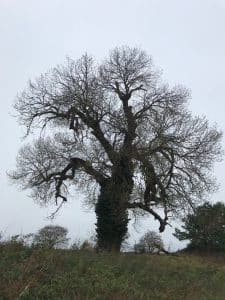
Birdwatchers often talk of identifying a bird at a distance just by its ‘jizz’, its characteristic outline and behaviour. We can all do this with people, too – you can recognise a friend or family member a long way off, just by their profile and the way they walk. Most trees have a very distinctive outline as well. When I was a child my parents tried to distract me on what then seemed to me interminable car journeys by playing a game of counting the different trees we could identify on the way. Once you got your eye in it was easier than you might think and we’d usually get quite a good tally in the ten miles or so before I asked, ‘Are we nearly there yet?’. Try it next time you drive children to Cambridge or Bury, as a green alternative to electronic toys.
Anyway, once you know the common trees any strangers start to stand out and I’ve seen some unusual tree species this month. One was in a scruffy churchyard with some Yews and it flummoxed me at first. But when I got close I could see some of last year’s leaves and shrivelled brown fruits on the ground and I noticed the smooth trunk was peeling away in chequered plates. Ah, Chequers, the old country name for a fine but now rare native British tree, the Wild Service.
We also visited the Gainsborough Gallery in Sudbury last month, which has a charming little garden at the back, once a herb garden or a domestic orchard, I guess. They have a trio there of ancient trees of great distinction – a large spreading Mulberry, propping itself up with twisted limbs bent down to the ground like elbows; a quince, famous in classical times for its ‘golden apples’, which make superb quince jelly (perfect with cheeses); and thirdly a Medlar, the fruit that famously goes rotten almost before it is ripe, but is delicious if you can catch it just right. None of these three is native to Britain, but they are now long-established residents and add great character to our treescapes.
My final encounter was the best, though. I unexpectedly came across a magnificent tree standing almost alone in a field on the Suffolk coast. And this time I did recognise it straightaway, since we have one in Thurlow too. It had a very characteristic tilt to it and deep corrugations in the corky bark. A Black Poplar, once common in East Anglia and a familiar feature in Constable’s paintings, but now endangered following the drainage of our water meadows for ‘development’. I couldn’t resist it. I gave it a hug.
Jeremy Mynott
4 March 2023
April 2023: Strange combinations
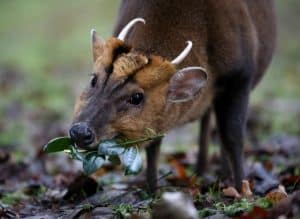
I was stumped by one of those Codeword puzzles the other day. I was looking for a seven-letter word with ‘tj’ in the middle, which is a rare combination in English. I could only come up with ‘straightjacket’, ‘bootjack’ and ‘nightjar’ – all of them too long. Well, I met the answer walking down the Drift that evening, as it ducked hurriedly into the pine copse. A ‘muntjac’. Muntjacs are small deer. They are not a native species and they still look rather strange in an English landscape. The unusual name is a clue to their origins. It’s derived from a Dutch word, which in turn comes from the Sundanese, a language from Java in the Dutch East Indies. Muntjacs are animals of Asian rainforests and were first introduced into Britain in 1925 by the 11th Duke of Bedford for his wildlife park at Woburn. Inevitably, some escaped and they have now spread rapidly northwards, reaching as far as Scotland and even Northern Ireland (the latter on assisted passage, presumably).
These origins explain some of their unusual physical features, too. They are our smallest deer – about the size of a large dog – and have a most unusual profile, with the hindquarters higher than the front end, so that they always seem to be walking downhill. That’s an adaptation to enable them to move easily through the dense vegetation of the Asian monsoon forests which are their natural home. It also explains their shyness – they are safe from predators in that dark tangle and communicate with each other more by sound than sight, hence their other common name of ‘barking deer’. It’s sex again, I’m afraid. Muntjacs breed all the year round and the females can conceive immediately after giving birth, so there’s always plenty to bark about. If you hear eerie barks and screams round here at night, it’s more likely to be muntjac than your neighbours.
Their other spooky adaptation is a set of long recurved fangs, very prominent in the males and quite disconcerting if you encounter one close up. Most deer have large antlers for mating displays, but those would just get caught up in undergrowth in the jungle. Moreover, the muntjac’s tusks are hinged and can be folded away when not needed for combat – so more like flick-knives than daggers. Neat but deadly!
It’s always a risk introducing a new species into an established habitat and muntjac can do quite a bit of damage browsing bushes and cropping such much-loved woodland flowers as bluebells and primroses. But I gather from a game-keeper I know that their venison makes very good eating, so maybe that points to a solution?
Jeremy Mynott
1 April 2023
May 2023: Hoping for a hummer
Is it a bird, is it a butterfly, is it a drone? What on earth is this exotic creature visiting your garden on a hot summer’s day? It buz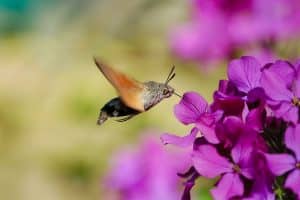
The whole hawkmoth family is very striking. Their caterpillars were thought to resemble the ancient Egyptian sphinx, hence their scientific name Sphingidae. Among these, the hummer, as it affectionately known amongst naturalists, is one of the few moths familiar and recognisable enough to have garnered traditional folk names. Their old country nickname in English was ‘merrylee-dance-a-pole’, while the French called it variously fleuze-bouquet (flower-sniffer’), saint-esprit (‘holy spirit’) and bonne nouvelle (‘good news’). Hummers have in fact long been thought a good luck omen and there is a story one would like to believe that on D-Day, 6 June 1944, a small party of them was seen flying over the Channel from France heading for England. In recent years they have been getting commoner and it is believed that a few of them now overwinter here, to emerge from hibernation in the spring. A very welcome addition to our native wildlife, if so.
The favourite food plant of their caterpillars is lady’s bedstraw, while the adult moths are especially drawn to flowers like lavender, verbena, honeysuckle and above all red valerian. When they find a flower-bed they particularly like they exhibit another remarkable ability, known as ‘trap-lining’ after the practice of trappers visiting their line of traps at regular intervals and in a fixed sequence. The hummers return to exactly the same patch of flowers at the same time each day, demonstrating an excellent visual memory for particular colours, routes and locations. Check it out yourself. You may have heard of song-lines and ley-lines – let’s plot our local hum-lines.
Jeremy Mynott
5 May 2023
